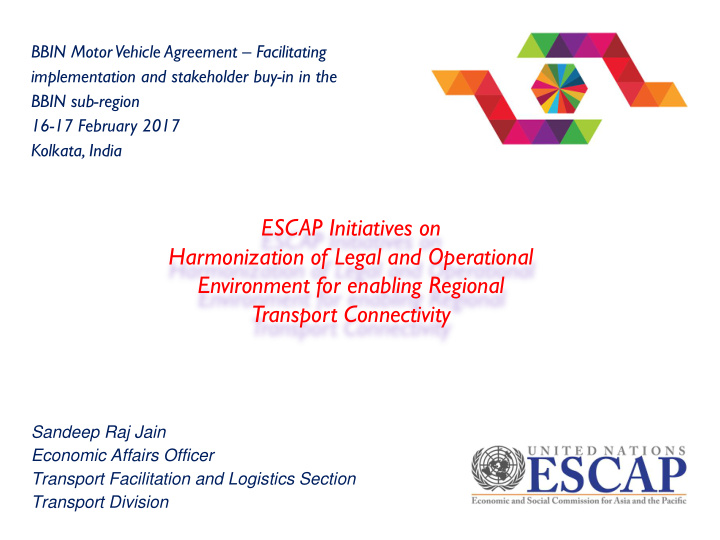



BBIN Motor Vehicle Agreement – Facilitating implementation and stakeholder buy-in in the BBIN sub-region 16-17 February 2017 Kolkata, India ESCAP Initiatives on Harmonization of Legal and Operational Environment for enabling Regional Transport Connectivity Sandeep Raj Jain Economic Affairs Officer Transport Facilitation and Logistics Section Transport Division
Outline 1. ESCAP initiatives on regional transport connectivity 2. Regional Strategic Framework for Facilitation of International Road Transport 3. ESCAP Transport Facilitation Tools
1. ESCAP initiatives to enhance regional connectivity- Background Inter Governmental Agreements on Asian Highway, Trans-Asian Railway Networks and the Dry Ports of international importance Transport facilitation is inherently challenging: Involves numerous government agencies and countries o Different institutional environment o Implementation capacities o Increasing importance of non- physical barriers and need for a comprehensive approach to tackle them. ESCAP member countries adopted in 2012 a Regional Strategic Framework for facilitation of o international road transport;
2. Regional Strategic Framework for Facilitation of International Road Transport Fundamental issues in facilitation of international road transport Road transport permits and traffic rights Visa issues Temporary importation of road vehicles Insurance of vehicles Vehicles weight and dimensions Vehicle registration and inspection certificate
2. Regional Strategic Framework for Facilitation of International Road Transport Key modalities for facilitation international road transport Building an effective legal regime Wider application of new technologies Development of professional training Establishment and strengthening of national coordination mechanisms Promotion of joint controls at border crossings Promotion of economic zones at border crossings Application of facilitation tools
3. ESCAP Transport Facilitation Tools Secure cross border transport model Provides concept for vehicle tracking system using new technologies such as SPS, RFID,CCS, Electronic Seals Balances control requirements and facilitation Physical inspection at origin/destination addresses concerns of security, diversion of goods Flexible institutional arrangements Practical ways for implementation Facilitates cooperation among border agencies both behind and across the border 6
Model Subregional Agreement on Transport Facilitation Overarching goal of the Model Agreement Propose a common framework with the aim of harmonizing the provisions of existing and future agreements for easier implementation and effective enforcement Contents Provides a checklist of issues typically contained in the subregional agreement Proposes a structure and brief description of structural elements and specific issues to be covered by the agreement Identifies issues that are best settled through additional subregional agreements NOT mandatory! Only for reference for drafting new as well as bringing amendments to the existing agreements Recommendations T o undertake a realistic assessment of negotiation and implementation capacity as well as of challenges that need to be solved through the agreement T o plan the implementation of the agreement T o avoid legal conflicts and ensure compatibility among the legal instruments e.g. consider the existing bilateral agreements concluded on traffic rights and permits
Model Bilateral Agreement on International Road Transport Overarching goal of the Model Agreement To Propose a common framework with the aim of harmonizing the provisions of existing and future bilateral agreements on international road transport, for easier implementation and effective enforcement Findings ESCAP countries use different approaches for arranging traffic rights from granting complete freedom to limiting the routes to border areas Given the divergence no uniform prescription is possible especially over short term Recommendations Over long term replace quantitative restrictions (quotas and permits) by qualitative ones Accordingly the Model Agreement has three options: First is for countries that grant limited access (designated routes and border crossings)- with the use of permits Second is for countries that provide permits with quantitative restriction(quotas) most common in the region Third permit free legal regime for occasional and permit requirement only for regular transport of passenger and goods NOT mandatory! Only for reference for drafting new as well as bringing amendments to the existing agreements
Model Multilateral Permit
Efficient cross-border transport model Evaluates the alternatives with respect to difficulty, cost, efficiency and reliability; encourages B2B and B2G cooperation Trailer swap: Trailer is detached from the prime mover and attached to another prime mover Container swap: Container is moved from one trailer to another, with cargo inside Manual transloading: Cargo transferred by hand or equipment from container or truck to another No transloading: Cargo carried by the same trailer and prime mover in both countries Prime-mover and container Manual transloading Prime-mover and trailer 10
Model on Integrated Controls at Border Crossings Provides for efficient information flow and sharing among various agencies at border crossings by application of modern technologies Promotes optimum use of modern equipment by different agencies Multiple use of the inspection results at border crossing Help in streamlining and simplifying formalities and procedures for crossing border with re-aligned integrated scheme for a border crossing Prevents duplication by aligning the inspection schemes for different agencies at the same border crossing
Desti tina natio tion Time-cost-distance model Sea transport Day 4 $400 Wait at Transport sea port to sea port Day 3 $300 Wait at border Day 2 $200 crossing/change transport mode Day 1 $100 Transport to border 500 km 1000 km 1500 km 2000 km Point t of Origin gin
Thank you for your attention http://www.unescap.org/our-work/transport
Recommend
More recommend